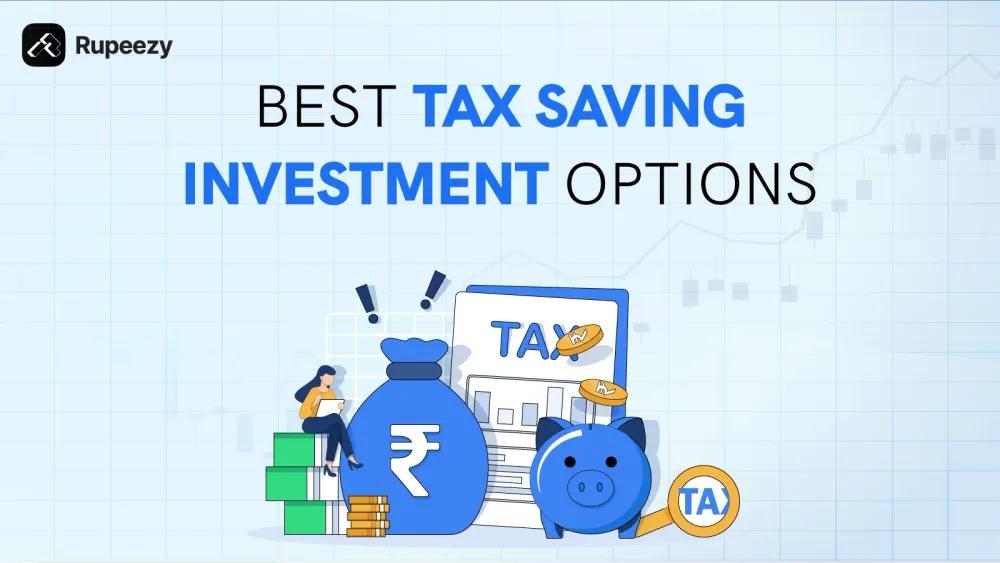Best Tax Saving Investment Options in India for 2026


00:00 / 00:00
Tax saving is an essential part of financial planning. Effective tax planning helps taxpayers to grow their finances and reduce the tax burden. In India, there are many tax saving investment options available to cater to everyone’s needs and preferences. Along with saving taxes, taxpayers can also gain returns on these investments. The Indian government has introduced many sections under The Income Tax Act that can lower the taxable income of an individual. We have brought you a comprehensive guide to the best tax saving investment options available in India for the financial year 2024 - 25, along with examples and details on how each option works.
List of Top Tax Saving Schemes and Investments in India
Sl No. | Investment Option | Tax Benefit | Lock-in Period |
1 | Public Provident Fund | Deduction of up to Rs. 1.5 lakh under Section 80C; Final amount received is also tax-free as per Section 10 (11) | 15 years |
2 | Equity-Linked Savings Scheme | Deduction of up to Rs. 1.5 lakh under Section 80C | 3 years |
3 | National Pension System | Deduction of up to Rs. 1.5 lakh under Section 80CCC; Additional deduction of Rs. 50,000 is allowed under 80CCD(1B) | 60 years |
4 | Tax Saving Fixed Deposits | Deduction of up to Rs. 1.5 lakh under Section 80C | 5 years |
5 | Unit Linked Insurance Plan | Deduction of up to Rs. 1.5 lakh under Section 80C; Final amount received is also tax-free as per Section 10 (10D) | 5 years |
6 | National Savings Certificate | Deduction of up to Rs. 1.5 lakh under Section 80C | 5 years |
7 | Employee Provident Fund | Deduction of up to Rs. 1.5 lakh under Section 80C | Until retirement |
8 | Sukanya Samriddhi Yojana | Deduction of up to Rs. 1.5 lakh under Section 80C; Final amount received is also tax-free as per Section 10 (11) | Till girl child attains 21 years or till marriage, whichever comes earlier |
9 | Senior Citizen Savings Scheme | Deduction of up to Rs. 1.5 lakh under Section 80C | 5 years |
Best Tax Saving Investments in India
Below we will explore the top investments for tax saving in India in detail.
1. Public Provident Fund (PPF)
The Public Provident Fund is one of the most popular tax saving plans baked by the Government of India. It is a right mix of tax savings, returns and financial safety. PPF scheme is a long-term investment vehicle that can be easily purchased by opening a PPF account at the nearest post office or private banks.
Feature | Details |
Eligibility | Open to all Indian residents |
Deduction | Under Section 80C |
Tax Benefits | Taxpayers can claim a deduction of up to Rs.1.5 lakh per annum on the amount invested. The interest earned and the maturity amount are also tax-free under Section 10. |
Interest Rate | 7.1% p.a. (Q2 of FY 2024-25) |
Lock-in Period | 15 years |
Minimum Investment | Rs.500 per annum |
Maximum Investment | Rs.1.5 lakh per annum |
Also Read: PPF vs Mutual Fund
2. Equity-Linked Savings Scheme (ELSS)
ELSS is one of the best tax saving investment options that offers flexibility and liquidity to investors. As the name suggests, it primarily invests in equities and related instruments. This tax saving investment is best suited for investors that are willing to invest in the stock market while saving taxes at the same time.
Feature | Details |
Eligibility | Open to all Indian residents |
Deduction | Under Section 80C |
Tax Benefits | Taxpayers can claim a deduction of up to Rs.1.5 lakh per annum on the amount invested. The interest earned is subjected to LTCG at 10% if the profit is above 1 lakhs in a financial year. |
Interest Rate | 5%-18% p.a. (it depends on fund's market performance) |
Lock-in Period | 3 years |
Minimum Investment | Varies as per different mutual funds |
Maximum Investment | No capping however max. Rs.1.5 lakh per annum is eligible for tax deduction |
Some of the best performing ELSS funds as per CRISIL ranking are as below:
1. SBI Long Term Equity Fund
2. Motilal Oswal ELSS Tax Saver Fund
3. JM ELSS Tax Saver Fund
4. Quant ELSS Tax Saver Fund
5. HDFC ELSS Tax saver
3. National Pension System (NPS)
NPS is a government-backed retirement savings scheme designed for both government and private firm employees. Tier-1 NPS account serves as the principal savings account for building retirement funds while Tier-2 account is a voluntary account (offered to individuals with active Tier-1 account) providing greater flexibility and accessibility of invested funds. Contributions to Tier 2 accounts do not qualify for tax exemptions. Salaried employees who are contributing to NPS can claim the following tax benefits on their own contribution:
Tax deduction up to 10% of salary (Basic + DA) under section 80 CCD(1) with the maximum limit of Rs. 1.50 lakh under Sec 80CCC.
Tax deduction up to Rs.50,000 under section 80 CCD(1B) over and above the limit of Rs.1.50 lakh under Sec 80CCC.
Feature | Details |
Eligibility | Indian Resident with age group between 18-70 years. |
Deduction | Under 80CCC and 80CCD(1B) |
Tax Benefits | Up to Rs.1.5 lakh per annum on the amount invested as per 80C. An additional deduction of Rs.50,000 under Section 80CCD(1) |
Interest Rate | 9%-12% p.a. |
Lock-in Period | Until you reach the age of 60. However, premature withdrawals upto 25% of total invested amount is allowed after a 3-years lock-in period. |
Minimum Investment | Rs.500 per month |
Maximum Investment | No capping |
4. Tax Saving Fixed Deposits (FDs)
Taxsaving FDs are another good tax savings investment option in India. There are many tax-saving FD options offered by banks in India with a lock-in period and offers fixed returns at the time of maturity. They are best suited for risk averse investors who are looking for tax saving investments with reasonable returns.
Feature | Details |
Eligibility | Open to all Indian residents with an active bank account |
Deduction | Under 80C |
Tax Benefits | Up to Rs.1.5 lakh per annum on the amount invested. The interest earned on FDs are taxable. |
Interest Rate | 5.5% - 7.75% p.a. (depends on the bank) |
Lock-in Period | 5 years |
Minimum Investment | Varies as per bank schemes |
Maximum Investment | Varies as per bank schemes |
Also Read: SIP vs FD
5. Unit Linked Insurance Plan (ULIP)
Unit Linked Insurance Plans are a two-in-one package of tax saving investment and life insurance plan offering tax saving benefits. This is suitable for individuals looking to reduce their tax liability while ensuring financial safety for their families. This is a versatile tax saving investment option that allows individuals to invest in different instrument types such as equity, debt or both as per their requirements and risk appetite.
Feature | Details |
Eligibility | Open to all Indian residents |
Deduction | Under 80C |
Tax Benefits | Up to Rs.1.5 lakh per annum on the amount invested. The death benefit received on maturity is tax-free as per Section 10(10D). |
Interest Rate | depends on the ULIP plan |
Lock-in Period | 5 years |
Minimum Investment | Varies as per ULIP plan |
Maximum Investment | Varies as per ULIP plan |
Listing down a few ULIP schemes that you can consider investing in this year.
1. Bajaj Allianz Future Gain
2. PNB Metlife Smart Platinum
3. MAX Life Fast Track Growth Fund
4. SBI Life Wealth Assure
5. HDFC Life Pro Growth Plus
Also Read: ULIP vs Mutual Fund
6. National Savings Certificate (NSC)
National Savings Certificates is a government-backed bond savings investment scheme beneficial for investors looking for long-term investment with guaranteed returns while saving taxes. These are primarily focused on small and mid-income investors. Individuals can buy NSC certificates either through post-office or online if they have a savings account under their name.
Feature | Details |
Eligibility | Open to all Indian residents with active savings account |
Deduction | Under 80C |
Tax Benefits | Up to Rs.1.5 lakh per annum on the amount invested. The interest earned on NSC is tax-free for the first 4 years, after which it is taxable as per income tax slab. |
Interest Rate | 7.7% p.a. |
Lock-in Period | 5 years |
Minimum Investment | Rs.1000 |
Maximum Investment | No upper capping |
7. Employee Provident Fund (EPF)
The Employee Provident Fund is a retirement tax saving scheme that provides several benefits to the salaried employees. Opening an EPF account is mandatory for any employee earning Rs.15,000 or above per month. The employer pays an equal amount of contribution each month to the employee's EPF account. Upon retirement, the employee gets the total sum of the accumulated fund of his share and employer’s share.
Feature | Details |
Eligibility | Open to all salaried employees earning Rs.15,000 or above |
Deduction | Under 80C |
Tax Benefits | Up to Rs.1.5 lakh per annum on the amount invested. The interest earned on EPF balance is also tax-free. |
Interest Rate | 8.25% p.a. |
Lock-in Period | Until retirement |
Minimum Investment | 12% of monthly salary |
Maximum Investment | No upper capping, however, if contribution exceeds Rs 2.5 lakh (Rs 5 lakh for government employees), only the interest earned on the amount up to Rs 2.5 lakh remains tax-free. |
8. Sukanya Samriddhi Yojana (SSY)
The Sukanya Samriddhi Yojana is a government initiative to promote the welfare of the girl child and encourage parents to save money for future expenses of the girl child like higher education and marriage. This tax saving investment scheme was initially launched as part of “Beti Bachao Beti Padhao” campaign however it became one of the most popular tax saving investments for mid-income parents who are willing to save funds for their daughters in regular internals until they become 21 or till the girl child gets married, whichever is earlier after account opening.
Feature | Details |
Eligibility | Open to all guardians till the girl child attains 10 years |
Deduction | Under 80C |
Tax Benefits | Up to Rs.1.5 lakh per annum on the amount invested. The interest earned on SSY investment is also tax-free under section 10(11A). |
Interest Rate | 8.2% p.a. |
Lock-in Period | Till girl child attains 21 years or till marriage, whichever comes earlier |
Minimum Investment | Rs.250 |
Maximum Investment | Up to Rs.1.5 lakh per annum |
9. Senior Citizen Savings Scheme (SCSS)
Senior Citizen Savings Scheme is a tax saving investment scheme launched for senior citizens (60 years old and above) by the Indian government that offers a safe and profitable investment option to senior citizens with attractive interest rates.
Feature | Details |
Eligibility | Open to all senior citizens aged 60 years or above. |
Deduction | Under 80C |
Tax Benefits | Up to Rs.1.5 lakh per annum on the amount invested. The interest earned on SCSS is taxable as per the applicable income tax slab if the interest exceeds Rs.50,000. |
Interest Rate | 8.2% p.a. |
Lock-in Period | 5 years (depositors can extend the maturity period by another 3 years) |
Minimum Investment | Rs.1000 |
Maximum Investment | Rs.30 lakhs |
10. Health Insurance Plan or Mediclaim:
Health Insurance covers hospital and medical expenses incurred due to illness or accident of the person insured in the policy. This is an important investment option to be considered by all income earners as it offers financial protection to self and family members against expensive hospitalization charges and other health expenses. The premium paid for health insurance is eligible for tax deduction under Section 80D to a limit depending on the members insured in the policy.
Taxpayers can claim a deduction under Section 80D for the payments mentioned below:
Health insurance premiums paid in any mode other than cash:
Up to Rs.25,000 paid for self, spouse, dependent children
Up to Rs.25,000 paid for parents (below 60 years)
Up to Rs.50,000 if parents are senior citizens (60 years and above)
Preventive health checkups (Cash payment allowed):
Up to Rs.5,000 for self, spouse, dependent children or parents
Here are a few options that you can consider while choosing health plans for your and your family. These plans have multiple benefits of pre and post hospitalization coverage, day care treatments, preventive health checkup, no claim bonus and restoration benefits and tie-ups with leading hospitals for effort-free cashless treatments.
HDFC ERGO Optima Secure
Care (formerly Religare) Care Supreme
Digit Health Infinity Wallet
Niva Bupa Reassure 2.0 Platinum+
Health Plans | Cover Amount | Cashless Hospitals | Premium per year | Add-on Benefits |
HDFC ERGO Optima Secure | Rs.10 lacs | 10,000+ | Rs.13,098 | 4X coverage after 2 years, 2X from Day 01 |
Care (formerly Religare) Care Supreme | Rs.10 lacs | 7,800+ | Rs.10,593 | Up to 600% increase in total coverage |
Digit Health Infinity Wallet | Rs.10 lacs | 10,000+ | Rs.9,774 | 100% cumulative bonus in 2 years |
Niva Bupa Reassure 2.0 Platinum+ | Rs.10 lacs | 10,000+ | Rs.9,188 | Unlimited restoration of cover, forever |
Read our latest blogs “How to Save Tax in India” and “Conveyance Allowance” to learn more about tax and finance topics!
Conclusion
Financial growth has two major aspects – increased profits and lower tax liability. While most of the investors focus on the former one, it is equally important to keep a check on taxes. Saving taxes can be a really big help to your pockets in a country like India where the taxes are considerably high. Hence, choosing the right tax saving investment option can lower the tax burden while offering a good return for long-term financial safety.
The content on this blog is for educational purposes only and should not be considered investment advice. While we strive for accuracy, some information may contain errors or delays in updates.
Mentions of stocks or investment products are solely for informational purposes and do not constitute recommendations. Investors should conduct their own research before making any decisions.
Investing in financial markets are subject to market risks, and past performance does not guarantee future results. It is advisable to consult a qualified financial professional, review official documents, and verify information independently before making investment decisions.

All Category










